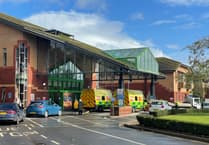South Hams is still seeing a significant number of virus cases, but numbers are starting to level off
The highest number of weekly coronavirus cases confirmed in the last seven days across Devon and Cornwall has been recorded – but most areas are now seeing cases fall.
More than 2,000 new coronavirus cases have been confirmed in the last seven days across the two counties, taking the total since the beginning of the pandemic to 15,982.
Cases has risen everywhere, except for Torbay and West Devon, but when looking at cases by specimen date rather than reported date, only North Devon is seeing a rise.
Government statistics show that 2,367 new cases have been confirmed across the region in the past seven days in both pillar 1 data from tests carried out by the NHS and pillar 2 data from commercial partners, compared to 2,068 new cases confirmed last week.
Of the 2,367 new cases confirmed since November 13, 478 were in Cornwall, 244 in East Devon, 220 in Exeter, 79 in Mid Devon, 170 in North Devon, 597 in Plymouth, 89 in the South Hams, 108 in Teignbridge, 263 in Torbay, 66 in Torridge and 53 in West Devon.
This compares to the 2,068 new cases confirmed between November 6 and November 12, of which 73 were in the South Hams, 440 in Cornwall, 217 in East Devon, 189 in Exeter, 67 in Mid Devon, 108 in North Devon, 496 in Plymouth, 100 in Teignbridge, 270 in Torbay, 52 in Torridge and 56 in West Devon.
Of the 2,367 new cases, 1,539 had a specimen date between November 13 and 19, with 51 in South Hams, 320 in Cornwall, 172 in East Devon, 153 in Exeter, 61 in Mid Devon, 103 in North Devon, 349 in Plymouth, 65 in Teignbridge, 182 in Torbay, 50 in Torridge and 33 in West Devon.
Despite more new cases being confirmed this week, by specimen date, cases have fallen, and graphs by specimen date show cases are only rising in North Devon.
In Cornwall, Exeter, Mid Devon, South Hams and Teignbridge, cases are fairly flat, while they are currently decreasing in East Devon, Plymouth, Torridge, Torbay and West Devon.
The number of people in hospital in the South West has risen to 942 from 759, although has only risen by six in the last two days, while there are currently 65 patients in mechanical ventilation beds, up from 58 as of last Friday.
NHS England figures show that as of Tuesday morning, there were 265 patients across Devon and Cornwall, in hospital after a positive Covid-19 test. Of them, there are 106 in the Royal Devon and Exeter (up from 69), 90 in Derriford Hospital in Plymouth (76), 18 in North Devon District Hospital (down from 19), 39 in Torbay Hospital (down from 43), four in Cornish Partnership Trust hospitals (3), six at the Royal Cornwall Hospital (4), and two beds in Livewell SouthWest facilities in Plymouth (4) taken up with patients after a positive Covid-19 test.
There are 19 patients in Mechanical Ventilation beds, up from 18, with one patient in Torbay Hospital, three at the RD&E, eight in Derriford Hospital, and seven in North Devon District Hospital, with none in Cornwall.
The figures show the amount of patients in hospital following a positive COVID-19 test who are currently occupying a bed.
But not every patient would necessarily have been admitted to hospital due to COVID-19, with a number of patients either contracting the virus inside the hospital, or being admitted for unrelated reasons but subsequently testing positive asymptotically when given routine tests.
NHS 111 data for Devon is down slightly up from last Friday, but Cornwall has nearly halved and is at the lowest level since August 14. The R-Rate for the South West fallen to 1.0-1.3 from 1.2-1.4.
In total, South Hams has now had 542 cases.
The total though has only risen by 1,911 for Devon and Cornwall after 204 cases were reassigned to other local authorities this week, meaning everywhere except Torbay and Plymouth on Monday saw the total number of cases fall.
It comes as Steve Brown, Devon’s Director of Public Health has issued a new plea to residents, said: “There is cause for optimism, without doubt. The challenge to us all – my plea to you – is that we do not let our enthusiasm to return to normal actually set us further back.”
In terms of the latest MSOA cluster maps, that cover the period of specimen dates between November 9 and November 15, the worst affected South Hams area is
Ivybridge with 17.
The COVID-19 cases are identified by taking specimens from people and sending these specimens to laboratories around the UK to be tested. If the test is positive, this is a referred to as a lab-confirmed case.
Confirmed positive cases are matched to ONS geographical area codes using the home postcode of the person tested.
Cases received from laboratories by 12.30am are included in the counts published that day. While there may have been new cases of coronavirus confirmed or people having tested positive, those test results either yet to reach PHE for adding to the dataset or were not received in time for the latest daily figures to be published.


